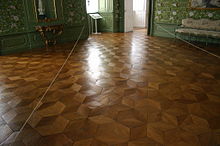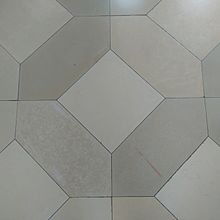Flooring
Floor covering is the floor covering of a building.
Classification
Floor coverings can be divided into textile coverings ( carpeting , fitted carpet ) and non-textile coverings . Classically laid carpets are not considered to be floor coverings because they are not construction-proof, but as normal furniture .
Textile coverings according to the material:
- Woven carpets
- Tufted carpets
- Knitted carpets (knitted carpets)
- Bonding carpets
- Needle fleece carpets
Non-textile coverings:
- elastic coverings
- homogeneous plastic coverings ( PVC , polyolefin coverings) this includes heterogeneous and homogeneous polyvinyl chloride coverings as well as composite coverings and CV coverings (CV = cushioned vinyl). PO coverings are floor coverings made of polyolefin
- multilayer plastic coverings (PVC, CV (cushioned vinyl) coverings)
- Rubber coverings (elastomer coverings) also called rubber or rubber coverings, in a homogeneous or heterogeneous design, with or without a foam coating
- Linoleum these include patterned and plain-colored linoleum coverings, linoleum with foam backing or with cork backing, and cork linoleum
- Cork coverings include cork pre-fabricated parquet, pressed cork panels and cork underlay
- Leather coverings
- Balatum
- Quartz vinyl coverings
- Hard surfaces
- Mineral coverings
A classification according to the load class is also possible.
See also
- Floor layer , the job
Individual evidence
- ↑ BauNetz: Types and forms of resilient floor coverings | Ground | Elastic coverings | Baunetz_Wissen. Retrieved January 8, 2020 .




